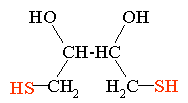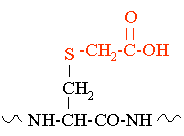|
An IonSource Tutorial |
||
| Monograph 0004 | ||
| S-Carboxymethylation of Cysteine Method Notes | ||
| .. | ||
| . | ||
| . | ||
| . | ||
|
Method
Notes: Step 2 Some resistant proteins benefit from; higher concentrations of the reducing agent, addition of a chaotrope and increased temperature. During the reduction of a very resistant protein we have used up to 80 mM dithiothreitol , 6 M guanidne HCl, at 60°C for 60 min.. Step 4 Make the iodoacetic acid up in 1M NaOH.
The iodoacetic
acid, dry reagent, should be a white flaky crystalline material. It
should not be brown but it can be slightly yellow. The color in
the reagent is free iodine which can oxidize your protein or
peptide. If the reagent is slightly yellow the excess DTT in the
reduction will quench this effect. Always make and use
the iodoacetic acid reagent fresh. Be careful with this reagent
it's dangerous, don't alkylate yourself ! Steps 5 and 6 Steps 5 and 6 can be bypassed with
a quick size exclusion or reverse phase purification. The down side of
dialysis is that it can take as long as 24hrs. The advantage of
size exclusion or dialysis is that the protein can be exchanged in to
the enzyme digest buffer.
|
|
|
 Iodoacetic Acid |
||
 Cysteine |
||
|
|
||
|
. |
||
|
TOC Introduction Reaction Method Method Notes Why Reduce? |
||
|
|
||
| - | ||
| - | ||
|
home
| disclaimer |
||

